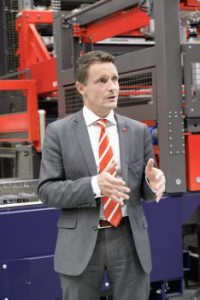The World Class Manufacturing program of Bystronic is set to debut at the

23rd International Sheet Metal Working Technology Exhibition (EuroBLECH) that will take place October 21-25, 2014, in Hanover, Germany. Oliver Hergt, editor of corporate communications at Bystronic, spoke with Johan Elster, head of business unit markets at the company, about it:
Oliver Hergt: Mr. Elster, this year, Bystronic will welcome its customers to EuroBLECH with the slogan “World Class Manufacturing.” What is behind it?
Johan Elster: With “World Class Manufacturing,” we provide our customers with the competitive edge. This slogan is based on a comprehensive program of products and services, with which we optimize the manufacturing processes of our customers—so profoundly that we are able to say, with us as a partner, users in the sheet metal processing sector become world-class manufacturers.
OH: What in your opinion is a world-class manufacturer?
JE: In order to be right at the forefront of competition, users require more than just a fast laser cutting system or press brake. Sheet metal processing consists of many individual stages. It begins with the drawing up of an offer, includes programming the cutting and bending processes, and ends with the delivery of the finished product. Anyone who has mastered all these stages and simultaneously releases the full potential for optimization at every stage is a world-class manufacturer.
OH: How would you sum up “World Class Manufacturing” in just a few words?
JE: With our program, users reduce their production costs, simplify their processes, and increase their efficiency. In addition, we provide functions that inform users about their processes and production data, anywhere and at all times.
OH: What challenges do users currently face in the field of sheet metal processing?
JE: We are noticing that added value is playing an increasingly important role for our customers. Previously, the focus was on time pressure. Everything needed to be faster—quicker-bending, faster-cutting. This focus has weakened. The pressure is shifting to production costs. Now, the objective is to produce parts as profitably as possible.
OH: What do you believe are the reasons for this change in trend?
JE: Sheet metal processors are faced with fluctuations in incoming orders and batch sizes. Every order that comes in must generate a profit. In such an environment, production costs are naturally very important.
OH: What trends do you currently see in the field of sheet metal processing?
JE: With regard to cutting, there is certainly a clear trend toward the fiber laser. The second most-important trend is increased automation. A further trend is the fast retooling of production systems because in the light of fluctuating batch sizes, flexibility in the field of cutting and bending is important. We have already discussed added value—I also consider this topic to be a trend.
OH: Are service products also a current trend?
JE: I would not—at least for the moment—consider them to be a trend. The traditional services that machine manufacturers offer, such as maintenance, training, and spare parts, are in principle not new. In the field of services, new products are only just being developed. From my point of view, this offers considerable potential for a coming trend. If we consider the entire process related to cutting and bending, services offer great opportunities to optimize.
OH: Let us talk about the fiber laser. In this area, a rapid development has taken place during recent years. What is your assessment of the current situation?
JE: In the foreseeable future, the fiber laser will certainly continue its advance into the CO2 laser’s range of applications. Currently, the benefits of these technologies are still balanced, but the advantages of the fiber laser are constantly increasing. In this context, particularly the trend toward added value is decisive; i.e., the question about how much a part costs to produce. In this respect, the fiber laser has significant advantages over the CO2 laser because it enables faster cutting speeds in the thin-to-medium range of sheet metal thicknesses, and is more cost-effective with regard to maintenance and energy consumption.
OH: What does this mean for Bystronic? Is your focus of development shifting?
JE: We recognized the trend toward the fiber laser at an early stage and reallocated our development resources accordingly. Now, we can draw on sufficient development potential to set new trends in fiber laser technology as well. But in this regard, I cannot reveal too much now—we will lift the veil at EuroBLECH at the end of October [laughs].
OH: Which fields of application do you believe will remain for the CO2 laser in the future?
JE: Currently, the CO2 laser still has an extensive range of applications. How this range will change in the coming years remains to be seen. In thick sheet metal, the advantages of the CO2 laser are still very pronounced. Customers who process the entire range of sheet metal thicknesses are still very well served with the broad spectrum our CO2 lasers offer.
OH: Thank you very much for talking to us, Mr. Elster.



